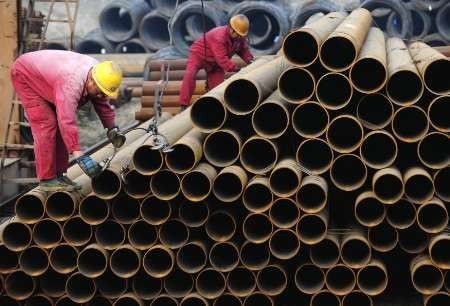Analysis: China's plan to create steel super firms seen

China is likely to fail in its drive for state-owned steel giants to swallow small mills and create iron ore super buyers to wring better prices from leading sellers Vale, Rio Tinto and BHP Billiton.
Failure to get the three major iron ore suppliers to agree to price cuts in 2009 was blamed on small mills breaking ranks -- a mistake China's latest five-year plan aims to fix by bringing more than 60 percent of national steel capacity under the control of its top ten producers by 2015.
China still doesn't have sufficient control over raw materials, so this isn't going to be an issue for firms like BHP and Rio, said James Wilson, an industry analyst with RBS.
China is not alone in seeking consolidation to lower raw material costs and stamp out over capacity, as demonstrated by a mega-merger planned by Japan's Nippon Steel Corp and Sumitomo Metal Industries that eyes the same goals.
China is the top customer for BHP, Rio and Vale, which all moved to quarterly price indexes in 2010 based on spot transactions in China. Now, however, BHP is pushing the envelope - asking Chinese clients to buy materials based on the average Platts index price one month before shipping.
Industry body the China Iron and Steel Association, keenly aware that the way prices are calculated can affect billions of dollars of imports, hopes to thwart any move to spot pricing by using its top buyer spot more aggressively.
But resistance is seen as futile.
They've got to come to terms with the fact that demand for the product is increasing significantly, and not just from China, Wilson said.
COSMETIC GESTURES
Cutting total steel capacity in China, variously estimated at 720 million to 750 million tonnes a year, roughly more than 100 million tonnes over 2010's output of 626.6 million tonnes, by forcing mergers and shutdowns may not work as well as market forces.
The government-led administrative push will not work, and the best way is to allow the market to play a major role in mergers and acquisitions, said Henry Liu, head of commodity research at Mirae Assets Securities in Hong Kong.
China's industry ministry last month said the top ten steel mills produced 48.1 percent of national output last year, up 3.6 percentage points from 2009 and close to its original target of 50 percent.
But analysts say that up to now, many of the consolidations have been cosmetic gestures to appease regulators.
The majority of mergers and acquisitions have been sought to create a simple sum of output, and haven't met the real target of regrouping assets and jointly utilizing resources, said Du Hui with China's Qilu Securities.
NATIONAL VS LOCAL
In Hebei, which produces about a quarter of China's total steel output, changes in the industry have already been felt.
Many of the ramshackle private mills that once dominated the local economy have been closed or relocated as Hebei strives to meet environmental targets.
It is also about to begin a punishing restructuring drive aimed at whittling down the total number of steel firms to 10 from about 88 in the next five years.
But while Hebei has been keen to eliminate some of its dirtiest and least efficient smelters, its policies have been designed mainly to head off takeover threats from beyond the province and keep crucial sources of tax revenues.
Hebei blocked takeovers of Tangshan Iron and Steel by the Beijing-based Shougang Group, and Handan Steel by Shanghai's Baosteel and instead ordered the two to merge and form the Hebei Iron and Steel Group in 2008.
The group has already become China's biggest steel enterprise, and over the last two months of 2010 it has acquired 10 percent stakes in 12 privately-owned steel mills in Tangshan and elsewhere, raising capacity by over 10 million tonnes.
The small mills have been fighting forever and I think they will continue to fight, especially if they are protected by local governments which rely on them for economic growth plus their tax base, said Sebastian Lewis, head of Asia research and consulting with Steel Business Briefing.
Still small mill owners in Tangshan told Reuters life has got tougher in the last five years with new regulations on water and energy usage and smelter sizes -- which are now combined with an expected demand slowdown as Beijing attempt to rein in a property boom stoking inflation.
Steel consumption growth is going to slow, partly as a result of government measures to move away from fixed asset investment and toward consumption, Lewis said.
Ultimately it isn't going to be government that encourages consolidation but the market -- margins are still pretty poor and there are going to be market exits.
© Copyright Thomson Reuters {{Year}}. All rights reserved.





















